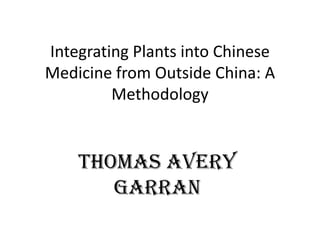
Integrating Plants Into Chinese Medicine From Outside China
- 1. Integrating Plants into Chinese Medicine from Outside China: A Methodology Thomas Avery Garran
- 2. Why is this important? Chinese medicine is an evolving system, if there is a way to improve it, we should try to do so. Although there are over 5000 plants used throughout China, only about 500 (10%) are used beyond local traditions. This is primarily because the best has been culled out and into the primary medicine. Difference between Chinese medicine practiced in the West and in Asia In the West many patients are already using some of Western herbs Western herbs are often higher quality The use of Western herbs is more sustainable
- 3. History Chinese medicine has long history of integrating plants from outside of Chinese into Chinese medicine Example: myrrh, frankincense, American ginseng, corn silk, turmeric, coix, evodia, cinnamon, etc.
- 4. Tools Historical usage Understanding thoroughly how a plant has been used historically Botanical relationships Very important as traditionally there have been plants used from same genus or even family as the same herb within Chinese medicine, ex. Chemistry Experience Knowledge and experience in Chinese medicine
- 5. Historical Usage Understanding the systems plants have been used in This can be complicated in the West Understanding the historical usage of plants Because of the above, this is both complicating and helpful
- 6. Historical Usage Looking at different descriptions of plant usage Finding similarities throughout this history Finding connections between descriptions in Western literature and Chinese theory and materia medica Hypericumperforatum Avenafatua Arnica montana Silybummarianum
- 7. Botanical Relationships History of using botanically related plants Many plants in Chinese medicine have been used as the same medicine; several species of Actaea (cimicifuga) used as sheng ma (升麻), Angelica as du huo (独活), Glycyrrhiza (甘草), etc. Family Relationships within families; Apiaceae (Heracleum being used as Angelica (独活), Asteraceae, etc. Genus polygala, calamus, cassia, actaea, clematis
- 8. How we can use these relationships A Western herb with related plant(s) in Chinese medicine; caulophyllum, angelica, polygala, calamus, lobelia, etc. Sometimes this there is very different information; lobelia Sometimes there is very similar information; calamus, angelica
- 9. Family Relationships Asteraceae Leucanthemumvulgare Apiaceae Ozmorhizaoccidentalis Lamiacea Melissa officinalis
- 10. Genus Relationships Polygala Chinese name 远志 (multiple species used) Angelica Multiple species used Ligusticum Chinese names 川芎 and 藁本 (multiple species used) Leonorus Chinese name 益母草 (multiple species used) Scutellaria Chinese names 黄芩 and 半支莲 and others * Scrophularia Chinese name 玄參 (two or more species used) Taraxacum Chinese name 蒲公英 (multiple species used)
- 11. Special Properties Flavor Understanding how the flavors function Nature The concept of a “temperature” in different systems may vary Understanding of the “over-all” function of the herb Channels entered Affinity to organs or areas of the body